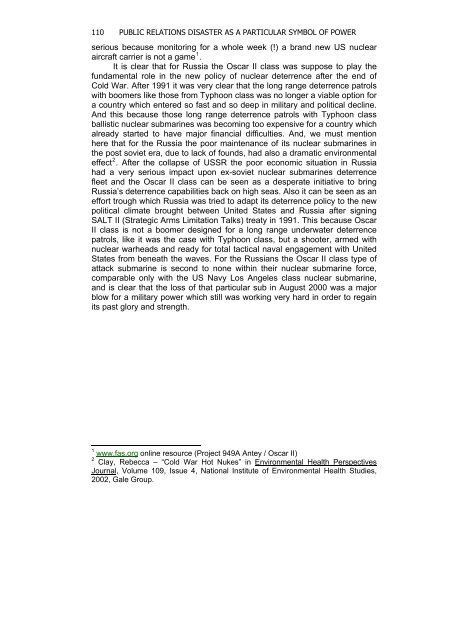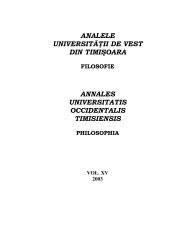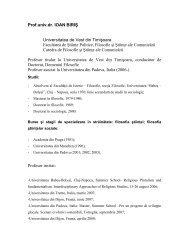VOL. IV (XXI) 2009 - Departamentul de Filosofie si Stiinte ale ...
VOL. IV (XXI) 2009 - Departamentul de Filosofie si Stiinte ale ...
VOL. IV (XXI) 2009 - Departamentul de Filosofie si Stiinte ale ...
Create successful ePaper yourself
Turn your PDF publications into a flip-book with our unique Google optimized e-Paper software.
110 PUBLIC RELATIONS DISASTER AS A PARTICULAR SYMBOL OF POWER<br />
serious because monitoring for a whole week (!) a brand new US nuclear<br />
aircraft carrier is not a game 1 .<br />
It is clear that for Rus<strong>si</strong>a the Oscar II class was suppose to play the<br />
fundamental role in the new policy of nuclear <strong>de</strong>terrence after the end of<br />
Cold War. After 1991 it was very clear that the long range <strong>de</strong>terrence patrols<br />
with boomers like those from Typhoon class was no longer a viable option for<br />
a country which entered so fast and so <strong>de</strong>ep in military and political <strong>de</strong>cline.<br />
And this because those long range <strong>de</strong>terrence patrols with Typhoon class<br />
ballistic nuclear submarines was becoming too expen<strong>si</strong>ve for a country which<br />
already started to have major financial difficulties. And, we must mention<br />
here that for the Rus<strong>si</strong>a the poor maintenance of its nuclear submarines in<br />
the post soviet era, due to lack of founds, had also a dramatic environmental<br />
effect 2 . After the collapse of USSR the poor economic <strong>si</strong>tuation in Rus<strong>si</strong>a<br />
had a very serious impact upon ex-soviet nuclear submarines <strong>de</strong>terrence<br />
fleet and the Oscar II class can be seen as a <strong>de</strong>sperate initiative to bring<br />
Rus<strong>si</strong>a’s <strong>de</strong>terrence capabilities back on high seas. Also it can be seen as an<br />
effort trough which Rus<strong>si</strong>a was tried to adapt its <strong>de</strong>terrence policy to the new<br />
political climate brought between United States and Rus<strong>si</strong>a after <strong>si</strong>gning<br />
SALT II (Strategic Arms Limitation Talks) treaty in 1991. This because Oscar<br />
II class is not a boomer <strong>de</strong><strong>si</strong>gned for a long range un<strong>de</strong>rwater <strong>de</strong>terrence<br />
patrols, like it was the case with Typhoon class, but a shooter, armed with<br />
nuclear warheads and ready for total tactical naval engagement with United<br />
States from beneath the waves. For the Rus<strong>si</strong>ans the Oscar II class type of<br />
attack submarine is second to none within their nuclear submarine force,<br />
comparable only with the US Navy Los Angeles class nuclear submarine,<br />
and is clear that the loss of that particular sub in August 2000 was a major<br />
blow for a military power which still was working very hard in or<strong>de</strong>r to regain<br />
its past glory and strength.<br />
1 www.fas.org online resource (Project 949A Antey / Oscar II)<br />
2 Clay, Rebecca – “Cold War Hot Nukes” in Environmental Health Perspectives<br />
Journal, Volume 109, Issue 4, National Institute of Environmental Health Studies,<br />
2002, G<strong>ale</strong> Group.




